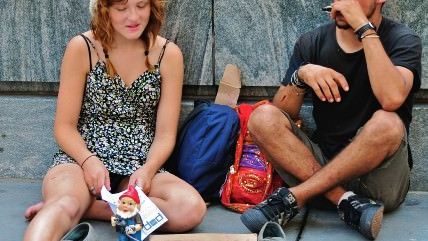Young, Bummed, and in Debt
The labor market looks bleak for millennials. Why aren't they angrier?

Until recently, a bad job market was nearly always bad news for political incumbents. Unemployed and anxious voters have a habit of throwing the bums out. But headed into the 2016 election season, one large demographic group is still likely to vote Democratic: millennials.
Which is weird, because when it comes to the labor market, it sucks to be young. To be sure, it has always been hard to enter the workforce during a recession. But this recession has not only been particularly severe; it has been made longer and deeper than necessary by the Obama administration's policies. Washington's burdensome regulations, "stimulus" spending, and health insurance mandates have given us a slow recovery, high uncertainty, and a pathetic job market.
According to the Bureau of Labor Statistics (BLS), some 1.2 million unemployed millennials with little or no job experience are trying to find jobs for the first time right now. Their unemployment rate is 12.2 percent, more than twice the rate for 25- to 54-year-olds. And if those first-time job seekers don't find employment soon, some of them may actually never work. "It is even more depressing," says my Mercatus Center colleague Keith Hall, a former BLS commissioner, "when you know that some 400,000 young long-term unemployed have never worked before." That's much higher than anything we have seen in the last 45 years.
It gets worse. In June testimony before the Senate Committee on Banking, Housing, and Urban Affairs' subcommittee on economic policy, Hall explained that "job prospects have been so bad that many have withdrawn from the labor force and do not even show up in the official unemployment rate statistics." According to his calculations, some 2 million young workers are simply missing from the labor force, and "if not left uncounted in the official unemployment rate, these 2 million would raise the youth unemployment rate from its current 10.9 percent rate to 15.4 percent-well above their highest rate in over 65 years." Only 63.4 percent of youth aged 18 to 29 are employed today, a pathetic and alarming figure.
Teenagers face even more abysmal prospects. The unemployment rate for 16- to 19-year-olds is 21 percent, down from its 27.3 percent peak in 2009 but up from 14.8 percent at the beginning of 1990. They are also more disengaged from the labor force than their slightly older peers, with a labor force participation rate of a very low 33.9 percent. Only 26.8 percent of older teens are employed, compared with 46.7 percent in January 1990, or even 37 percent at the end of 2006.
Joblessness is costly, especially for young adults who have invested time and resources in career-specific knowledge and skills. Studies consistently show that the longer people are unemployed, the less likely they are to find new work. They may lose their job skills over time, have less connections with informal professional networks, or face potential employers more reluctant to hire the long-term unemployed.
Those who finally do get a job after looking for a long time will continue to face a disadvantage. It can take as long as 20 years for re-employed workers to catch up on lost earnings, mostly due to skill mismatches between the jobs lost and the new jobs created in the economy. These losses occur for workers with different lengths of previous job tenure, across all major industries, and of any age, including millennials. Hall notes that recent estimates have found that the losses "range from 1.4 years of earnings in good times to 2.8 years during times of high unemployment."
And none of those ugly figures capture the problem of underemployment: part-time and/or lower-paying jobs. Currently employed seniors tend to hang on to their jobs rather than retire, as they work to rebuild some of the assets they lost during the Great Recession, so younger workers are finding it hard to move up the work ladder.
Older workers also don't quit their jobs as often as they used to. The number of quits, defined by the BLS as "generally voluntary separations initiated by the employees," serves as an indicator of the health of the labor market. A high quits number tells us that people are willing or able to leave their jobs for better opportunities. Five years after the recession ended, the quits rate hasn't grown as fast as one would hope. At a 1.8 percent level, it is still lower than it was at the beginning of 2007. The consequence is stalled careers for younger Americans.
While millennials struggle to find jobs and grow their wages, previous generations continue to expect them to foot the bill for trillions of dollars of unfunded liabilities and entitlement promises. Add that tab to their student debts, and the situation looks unsustainable.
So why aren't these kids more freaked out about their future? Why did the youth-driven Occupy Wall Street movement fizzle out instead of becoming the new normal? The July Reason-Rupe poll suggests one possibility: Millennials define themselves politically in cultural terms rather than economic terms. This aversion to economics may be a product of growing up in a time when the economic headlines have always been bad.
Paradoxically, millennials also live in an age of abundance, collapsing prices, and promising technologies. They may be un- and underemployed. But the online realm, where younger people live much of their lives, is faster, freer, and more fun than ever.
If the economy doesn't improve, reality will catch up with this generation. When that happens, let's hope they demand the same freedom in their economic lives that they have grown to expect in their social lives.


Show Comments (437)